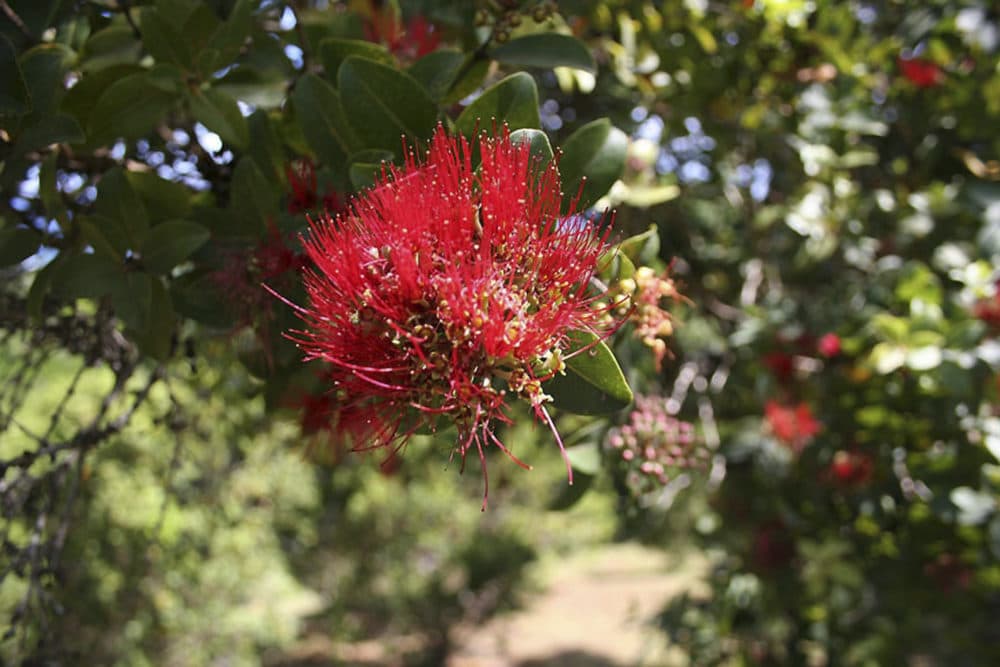Advertisement
Often Overlooked, Declining Plant Biodiversity Sows Trouble For Humans
Resume
Earlier this week, a United Nations report found humans are now driving more species to the brink of extinction than at any other time in history.
Roughly 1 million of the Earth’s 8 million known species of plants and animals are at risk of going extinct, according to the report.
“We have to acknowledge how grim this report is, and people really need to wake up to the reality of the situation we're in,” biologist Andi Wolfe tells Here & Now’s Peter O’Dowd.
While that statistic includes large animals such as elephants and orangutans, some scientists say we should be just as concerned about threats to plant life — which they say is often overlooked.
Wolfe, president of the Botanical Society of America and a plant biology professor at Ohio State University, says we as humans need to understand how important plants and natural environments are to our lives. She calls the lack of acknowledgement “plant blindness.”
Part of overcoming that blindness is recognizing that protecting plants is just as important as protecting animals, she says.
“I really want to emphasize that we absolutely rely on plants for our existence,” Wolfe says. “From an ecological standpoint, plants are the primary producers in any ecosystem. They're the ones that can make food out of just the basic ingredients of sunlight, water and some mineral nutrients. So everything depends on plants as the primary producers.”
Here’s the good news: There’s plenty of ways to curb the current crisis, Wolfe says.
And her solution isn’t as complicated as you might expect.
People can begin to turn the tide on plant and animal extinction by taking a deeper look at what makes them happy, she suggests.
“It really would take a complete change in our our thinking in terms of what quality of life means, she says. “We live in an age where consumerism is our measure of happiness — the more you have, the happier you are. But there are other places in the world where that's not the way life occurs, and these people are very happy. So there needs to be a change in the way we think about, ‘What do we need to be happy?’ ”
Interview Highlights
On how many plant species there are
“The estimate ranges from about 391,000 to about 500,000. You have to keep in mind that we're naming 2,000 new species of plants every year, so the numbers are growing.”
On why protecting plants is just as important as protecting animals
“Plants are the start of the food chain, obviously that's one of the most important things. Over 4 billion people rely on firewood for their primary fuel source. We use wood for shelter. We use bamboo for shelter. We rely on plants for our medicines. We rely on plants for fibers, for oils, for defense mechanisms. We use them for pest control. We use them in industrial compounds and we use them for stimulants, pigments and paper and everything you can imagine depends on plants. People should care about plants, but people don't really understand the significance of plants because in everyday life, you know, watching nature show on TV, it's probably about an animal. But plants are fascinating creatures and people really should know more about them.”
On plant species that have either gone extinct or are on the verge of going extinct because of humans
“Well you can almost name any plant on the island of Hawaii as in danger of extinction. Think about the number of plants that you're familiar with on Hawaii. Most of those plants are not native to Hawaii. And there are many plants that are on the brink of extinction or have almost already assuredly gone extinct.
“Of course, invasive species is probably one of the primary impacts. But think about how people use the land. I mean, think about the island of Oahu and think about Honolulu, what that might have looked like 100 years ago compared to what it looks like today. Urban development is a primary cause. Infrastructure development is a cause. Agriculture is a cause. Island systems are particularly prone to problems with rarity and extinction.”
On plant life at risk in the U.S.
“If you think about [the] western United States, a lot of our land out West is public land. One of the highest impacts to native plant life in the western states is from cattle grazing. So just by having cattle on land that never had cattle before, I mean we had buffalo of course, but their behavior is quite different than rangeland cattle. They eat everything, except for the poisonous plants and the ones that have a lot of thorns and defense mechanisms. So when you have that type of disturbance on the landscape, the native plants are not adapted to that type of pressure.”
On the argument that we need cattle and farms to expand to food production
“But you know what's really interesting is that we don't need meat to survive. We actually can get all of our nutrients from a plant diet. Now I'm not a vegan and I'm not a vegetarian, but I primarily rely on plants for my food source and the ecological impact of growing plants and consuming plants is much less than the ecological and environmental impact of consuming meat.”
On invasive grasses — such as those in California — that can dry out plants’ ecosystems
“Think about California. California is one of our biodiversity hotspots. We're very fortunate to have that much diversity of plant life in a very compact area. The California floristic province ranges from southern Oregon down to Baja California. The annual grasses that are invasive species are very bad for plant diversity, not only in replacing the plants that are native to the area but because they grow so fast and they dry out so quickly, they become fuel for these these annual fires.”
On solutions to the extinction crisis
“One thing is to help people understand the importance of plants. I mean, just get over that plant blindness factor in the first place. But beyond that, just understanding the importance of having natural environments. Now, one of the problems we have is that in making decisions about where to set aside lands that are protected, right now it's only the leftover bits of pieces that are able to be set aside. You're not going to push people out of the Los Angeles basin to let the California floristic province recover. But actually even if you just set aside patches of land, it's amazing how much diversity you can retain. One of the primary dangers for extinction is the loss of genetic diversity. So if you have a small reserve and you have a very small population, what you end up with over time is the loss of individuals and when you lose those individuals, you lose that genetic diversity that they carry. You get to a critical threshold where they really don't have the genetic means to recover from a natural disaster. So just having larger populations and having the ability for things to be spread across a geographic region can be a huge benefit to mitigating the problem that we're seeing with this extinction crisis.
“It's very easy to ignore what's going on in other parts of the world. But when you're in a situation where these losses of species can have a huge impact on yourself, then people might start to pay more attention.”
Chris Bentley produced this interview and edited it for broadcast with Kathleen McKenna. Serena McMahon adapted it for the web.
This segment aired on May 9, 2019.

